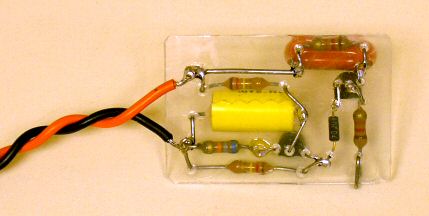 |
|
||
Ethan's Audio and Music Bio Page
Read all about
Ethan's |
My desire to pursue a career in audio and music began as a teenager in the mid-1960s. I enjoyed playing the violin in elementary school, but my passion really took off when I started playing the electric guitar at age 16 in 1964. After several years of practice I noticed that some days I could play a difficult passage perfectly, but not so well other days - especially when I wanted to show off for a friend! That drove my desire to get a tape recorder, and eventually the lifetime goal of learning all about audio, recording, and music. Knowing how to use audio equipment is great fun, but for me understanding how things actually work is even more fun. I never got a degree or even went to school for electronics, but I worked as a technician with many excellent "real" engineers. I asked endless questions, and learned a lot, and by the 1970s I had designed and built equalizers, compressors, analog synthesizers, and even an entire 16-channel recording and mixing console. This page documents my journey.
THE 1960s
One of my first electronics projects was in 1962 at age 13, when I built a low-power AM radio transmitter from plans in a magazine. I drove my parents nuts playing Bert Kaempfert's Afrikaan Beat over and over as I walked around the house and back yard listening on a portable radio. I also got a ham radio license around that time, though I didn't find talking to strangers via Morse code nearly as much fun as building audio and radio devices.
When I was 17 in 1966 I built my first recording studio in my parents' basement in East Norwalk, Connecticut. I had bought a 1/4-track Sony open reel tape recorder with sound-on-sound capability. This let you record one (mono) track, and then copy that to the other track while also mixing a new source through the microphone or line input. There was only one chance to get the balance correct, and after only a few passes the tape noise and distortion became quite objectionable. A year later I bought a second Sony stereo tape deck and also a four-track record/play head. I mounted this head in the first recorder, replacing the existing head, and ran wires from the second deck to the extra track windings on the new head thus making a four-track recorder. This let me record and play four tracks all at once or separately, though I used this setup mainly to record and overdub instruments one by one to build a complete performance by myself.
My parents were good friends with Erv and Muriel Nussbaum, and I occasionally baby sat for their young son Adam who was unusually precocious with an intense interest in music. One night while his parents were out we reached behind his father's expensive stereo receiver and plugged my electric guitar into the phono input. Wow, cool distortion! Adam has since gone on to become a world-famous jazz drummer. More name dropping: At that time I also played lead guitar in a band with John Scofield. Like Adam, John went on to become really famous with dozens of CDs.
 |
Also around this time I started designing and building miniature fuzz-tones and compressors into guitars for friends and others. The photo above shows a typical construction, and the schematic below show a tiny fuzz-tone I built into my Fender Telecaster. (Click the image to see or download a larger clearer version.) The circuit board is barely an inch long, and all the wiring is (obviously) point to point, using each component's leads to connect to the adjacent parts. A 9 Volt battery is under the guitar's pick guard. One clever feature is having the battery disconnect automatically when the guitar cord is unplugged, by using the right channel of a stereo phone jack as the battery's ground connection. Today this is standard on most battery devices that have a 1/4 inch input or output jack.
Between my interest in music and electronics, my "stereo" at that time was a Fender Bandmaster guitar amplifier for the left channel, a Fender Bassman for the right, and a home-made RIAA phono preamp that ran off a 9-volt battery. The two amplifiers and their speakers were similar so it didn't sound mismatched, though of course I set the tone controls the same on both amplifiers when listening to records. Back then my friends and I thought it sounded great, and it could play very loudly!
In the late 1960s I also started working as an electronics technician. One of my fondest memories was building RF splitters for Anzac Electronics, some of which went to the moon! The RF splitters I made at Anzac were like the little gizmos that split a cable TV signal to two or more television sets. Only these cost a whole lot more and were sold to industry and the US Government. As an aside, Anzac was started and run by Carl Sontheimer, who later when on to create Cuisinart, the first home food processor. Another fond early memory was working for Vectron, a manufacturer of precision crystal oscillators. I learned a lot during the years I worked at these companies, and was fortunate to have some truly gifted engineers answer my endless electronics questions. After Vectron I worked for Cober Electronics building enormous high-power tube testers.These devices are the size of a small bedroom, with power supplies that put out 50,000 volts! I also met my RealTraps partner Doug Ferrara while working at Cober.
THE 1970s
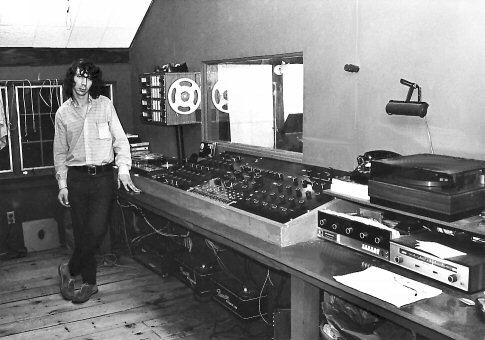 |
This is the first recording console Ethan built. Photo by Kevin Byron, 1972 |
My first real studio - with separate rooms for recording and mixing - was in Weston, Connecticut, in 1970 in a barn owned by my friend Jim Geraghty. Jim and I bought a used Ampex AG-440 1/2 inch 4-track recorder and built our own mixing board, and we recorded local bands for $25 per hour. We also bought a used Telefunken (Neumann) tube U47 microphone for $250 (!), a Revox A-77 half-track recorder for mixdowns, some cheap Radio Shack condenser microphones, and two crappy spring reverb units. We never made enough money to justify our investment, but we sure had a lot of fun.
One of the best projects we recorded here was Mick Leonard's band Road Apple, and amazingly Mick still had these final mixes:
Chorale (8.5 MB)
Untitled (8 MB)The band:
Mickey Leonard: Guitar
Billy Bacon: Drums and Percussion
Jeff Bova: Keyboards
Dewey Dellay: Bass
Faith (Fraioli) Glassman: Violin
Both tracks mastered by Peter Hodgson
I also built my first home-made synthesizer during this period, with much help from my friend Leo Taylor who was an engineer at Hewlett-Packard. This synth was modeled loosely after a MiniMoog except it had no keyboard - only two oscillators, a voltage-controlled filter (VCF), and a voltage-controlled amplifier (VCA). Since I couldn't afford a real MiniMoog I had to build my own. In this case poverty was the mother of invention! In what was surely one of the earliest attempts by anyone to sync a computer with an audio tape recorder, Leo and I recorded a short tune written by my friend Phil Cramer. We started by recording 60 Hz hum - called Cycles Per Second back then - onto one track of the AG-440, and that hum was then squared up (distorted to become a square wave) and played back into the control port of a small H-P 2114 computer that Leo borrowed from work. Small, as in it barely fit on a tabletop. This computer had 8k of core memory, a D/A converter to output analog voltages, and a tape reader to store the code and data. Leo wrote a program in binary machine code to read the 60 Hz sync signal, entering it step by step on the computer's 16 front-panel toggle switches with the D/A output controlling the synthesizer. The data for the tune, essentially a three-part invention, was also entered via the computer's toggle switches. It took us 11-1/2 hours to program the computer, enter the data, and record the three tracks. You can hear the result HERE.
In 1974 I built another synthesizer. This one was much more ambitious than the first and included a 61-note keyboard, four oscillators, two VCFs and two VCAs, an LFO, a ten-step sequencer, and circuitry to split the keyboard electronically at any point so both synthesizer "halves" could be played simultaneously for a whopping two-note polyphony. You push and hold the Set Split button to the left of the keyboard, then pressed a key on the keyboard to establish the split point.
 |
Leo Taylor and I met every Monday night for two years to design this synthesizer, then I spent another nine months building it. Leo was the real brains, though I learned a lot about electronics over those two years. By the end of this project I had learned enough to design all the keyboard, LFO, and other control circuits myself. Fourteen separate plug-in circuit cards are used to hold the various modules, and each card was hand-wired manually using crimped wiring posts and 24 gauge buss wire with Teflon sleeving. Keyboard magazine featured this synth in their Keyboard of the Month column in the January 1998 issue (see the article HERE).
 |
 |
I still have this beast in my basement, but it's been years since I've fired it up. You can hear it in action on Disco Rainbow, recorded ca. 1977, on my tunes page.
Also during this period Leo and I designed what was probably the first electric guitar synthesizer based on a pitch-to-voltage converter. I tried to sell the design to Electronic Music Labs (EML), a synthesizer manufacturer in nearby Vernon, Connecticut, but they were too short-sighted to see the potential market. Another audio product I invented that was ahead of its time and thus financially unsuccessful was a third-octave self-adjusting room equalizer described in detail in THIS article for Live Sound International magazine. Each equalizer band has a pair of LEDs that let you know when that band's level is properly adjusted for a flat response. A built-in pink noise source is played through the monitor speakers, a calibrated microphone feeds a separate input on the equalizer, and the LEDs tell you if the slider for each band is too high or too low. Today devices like this are very common!
 |
In the mid-1970s I partnered with Rob Carlson, who bought a 16-track 2-inch MCI recorder to go with the 16-input console I built and designed with the help of my engineering mentor Bill Eppler. Rob was a valuable partner because he had a strong local following for his standup act, and is an excellent song writer with contacts in the advertising business. So we had not only a real studio (built in the enormous freezer of a former dairy) but also the ability to make full-time livings producing jingles and corporate sound tracks.
|
We did numerous projects, many for well-known companies such as Stanley Tools, Aetna Life Insurance, Pitney-Bowes, Blue Cross, and the Connecticut Lottery. We also recorded Narada Michael Walden's current band at the time. When our third partner revealed himself to be a cheat, we packed up our gear and began a two-year project to build another studio in East Norwalk, Connecticut.
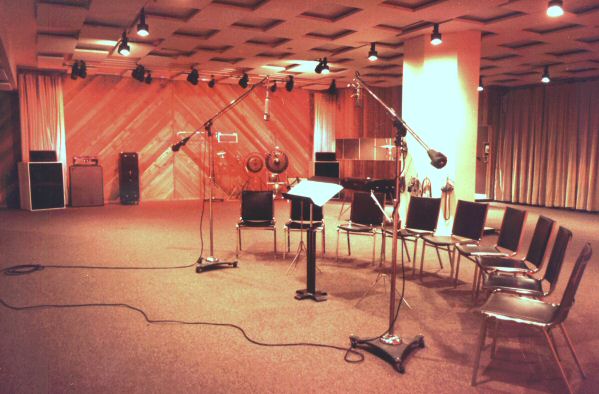 |
The Recording Center, 1979 |
The Recording Center was a full-blown commercial studio, and we continued to record jingles and industrial sound tracks, and also an ongoing stream of local and almost-name bands. I taught recording classes four nights per week in this studio, and also for a few semesters for the University of Bridgeport. As you can see, the studio area was large enough to hold an entire orchestra comfortably, and the spacious curved drum booth in the rear seems tiny compared to the rest of the room. Each of the two walls visible in the photo above had very thick and deeply pleated "stage" curtains that could be opened or closed to control the room acoustics. There were five rooms altogether in this 6,300 square foot facility: The main studio (above), the control room (below), a large "piano room" with a hardwood floor (not shown), a large heavily treated vocal booth next to the piano room, plus a separate "Studio B" for voice-over work and cassette duplication.
 |
The Recording Center, 1979 |
The control room was also quite large, with huge double glass windows into the main studio and also the "piano room" (not visible). I designed the layout for this studio myself, but we hired the acoustic consulting firm of Klepper, Marshall, and King from New York to confirm the design. They showed us how to build floating floors, walls, and ceilings, and how to build proper bass traps and acoustic treatment. In the upper-right corner of the control room photo above you can just make out the lighting control panel. Each of the eight lighting tracks had its own on-off switch and 1500-watt variable transformer dimmer.
A few weeks before the studio had its opening "gala" party, we invited Dave Hart and his band Taxi to record some songs to show off the facility. This is one of the first tunes ever recorded in that room. The recording and mix are by studio partner Peter Hodgson, who recently found the original tapes. Thanks Peter!
The band:
Guitar: Dave Hart
Keyboards: Rob Aries
Bass: Cliff Pia
Drums: Rob Usher
Saxes: James "Doc" Halliday
In the late 1970s I also began a side career of writing for audio magazines, starting with a series of technical and how-to articles for Recording Engineer/Producer. The magazine is long gone, but the preceding link goes to an archive of their back issues. My articles that are still relevant are on my own Articles page.
THE 1980s AND 1990s
After five more years in the studio I'd had enough, and in 1983 I took a detour into audio and software consulting where I designed business programs for the Lawn Doctor, the New York Stock Exchange, and Chase Manhattan Bank. I also worked as chief engineer for ByWord Corporation where I designed and installed guided tour systems for museums and other tourist attractions. The best part about ByWord was the traveling - I went all over, including four trips to Bermuda, three to Las Vegas, and many near Disney World. I also spent six weeks in Beulah, North Dakota, in the middle of winter, which was no fun at all!
In 1986 I started a business to design and sell add-on libraries for programmers. These included sophisticated program fragments that most programmers would find too difficult or time-consuming to write themselves. We were sort of the "expert's experts." During that time I switched from writing about audio to writing about computers, writing dozens of articles for the major programming magazines, and I also was a contributing editor for PC Magazine. One of my fondest memories is an event at the 1988 Comdex show in Las Vegas when PC Magazine rented a small ball room and band instruments for a PC Magazine editor's jam session. Jeff Prosise and Doug Boling (guitars), Neil Rubenking (keyboard), and I had a ball playing for many hours. I don't recall who played the drums, but Wayne Hammerly, formerly of Three Dog Night's touring band and then a software vendor, also sat in.
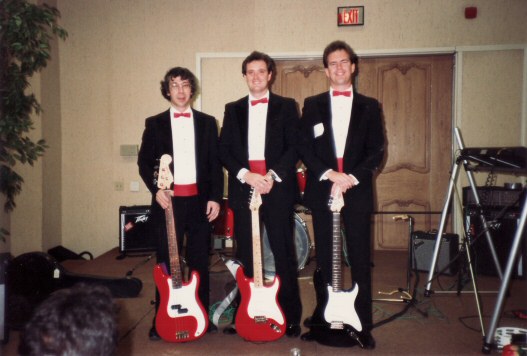 |
1988 Comdex, from left to right: Ethan Winer, Jeff Prosise, Doug Boling |
Besides writing for computer magazines, I also wrote an expert-level programming book that became a best-seller. The book reached Number 11 on the Waldensoft Top 20 list, which was surprisingly successful for a programmer's book competing in the same market as "Word Perfect Made Easy" and other titles having a much wider audience. PC Magazine BASIC Techniques and Utilities is now out of print, but it's available on my Programming page for downloading.
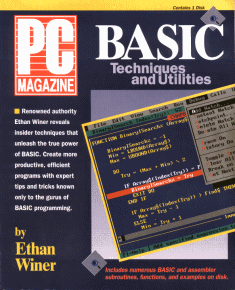 |
My software company also co-produced programming events with Microsoft, and I won their Developer MVP Award several years in a row. During that time I met Bill Gates and even had dinner with him!
 |
I sold my software company in 1992 and retired so I could spend more time with audio and music. I also bought a bunch of new audio gear and started playing the cello. I continued writing for magazines, only now it was for Strings, The Strad, Electronic Musician, and Recording instead of PC Magazine, Microsoft System Journal, and PC Techniques.
 |
Kate Dillingham |
I've always enjoyed classical music, and had attended the University of Bridgeport for composing and arranging courses in the mid-1970s. So it was a natural progression to learn the cello and start playing in local orchestras. I was fortunate to hook up with Kate Dillingham (above), a fabulous cellist and teacher. Besides taking lessons with Kate, together we produced a cello CD for Music Minus One (now a division of Music Dispatch) and also four one-hour Cello Masterclass videos with her teacher, Bernard Greenhouse, of the famous Beaux Arts Trio. I have since recorded and produced a half-dozen CDs for Music Minus One in my home studio, including a recording of my own cello concerto described on my Concerto page.
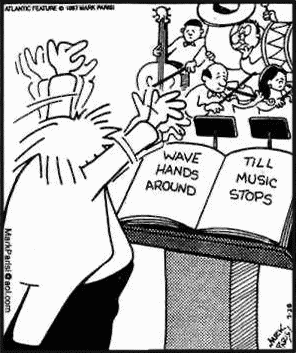 |
At that time I practiced the cello for three to five hours every day, playing regularly in three area orchestras, plus a string quartet, a piano trio, and in a duo with a pianist. But after creating my Cello Rondo video in 2006 (which now has nearly 2 million views on YouTube and elsewhere) it became clear I was too old to ever become a truly great player no matter how much I practiced. So currently I play only occasionally, and practice daily only when working on a new piece I'll record or make into a video.
In 1994 my wife and I moved into our present home in New Milford, Connecticut, and I built what I swear is my last recording studio (below). This studio has the recording and mixing areas in the same room, which is rarely a problem since I record mostly myself and friends. When I record others I simply use earphones while tracking, and defer all EQ and balance decisions until mixing. The room is 33 feet long by 18 feet wide, and the side walls and ceiling are angled to avoid flutter echoes. I also use this room for video projects. Bass traps surround the mixing area on both sides and the ceiling, and additional traps are on the rear walls. A list of all the current audio equipment is on my tunes page.
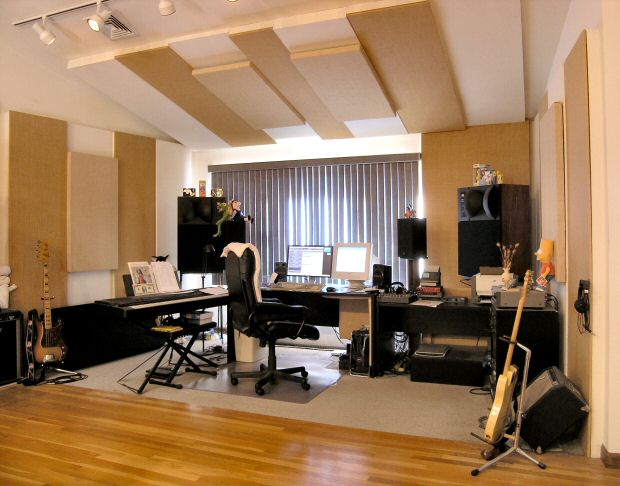 |
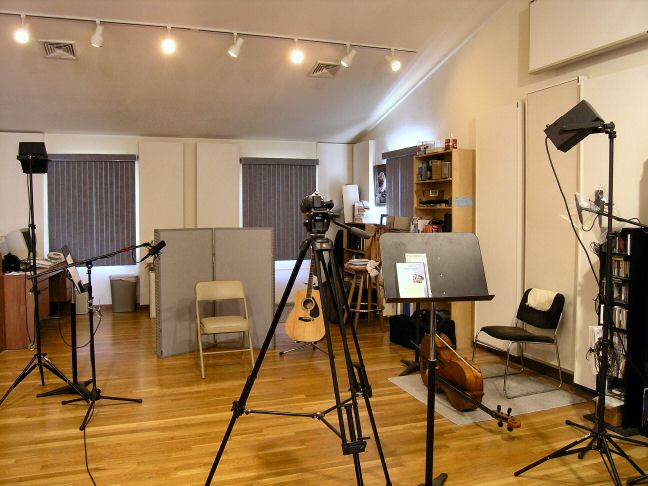 |
I wrote my first piece for full orchestra, A Day in the Life of a Cat Named Bear in 1996 (on my Tunes page), and in 1998 wrote a cello concerto which I recorded in this studio piece by piece using live musicians (as opposed to synthesizers).
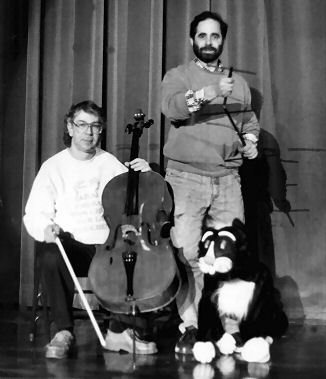 |
Bear has been performed by four different area orchestras, and has even had a puppet show created for it (above) by the Robert Rogers Puppet Company.
THE 2000s
Early in 2001 my friend and later business partner Doug Ferrara and I sold all our outboard recording equipment, and switched to using only a computer. This type of recording and mixing is called "In The Box," and in my opinion is far better than dealing with many separate pieces of audio equipment. Doug and I also started the company RealTraps to manufacture high performance acoustic treatment. This was a very successful venture with clients including Herbie Hancock, T Bone Burnett, NBC Universal Studios, Pixar, Microsoft, Georgetown University, Toyota, Subway, NASA, Google, William Morris Agency, Ogilvy & Mather, McGill University, Columbia University, TMZ, Berklee College of Music, US Army, Fox Sports, MIT, Timbaland, Epcot Center, Starz TV, The Onion, Oxygen TV Network, Dolby Labs, CBS News, Notre Dame, Sony Music Entertainment, VISA International, ESPN, Warner Brothers Records, NASCAR, Princeton University, American Public Medium (NPR), National Geographic Society, Amazon, and many others.
These days I'm semi-retired, doing occasional audio and acoustic consulting both for local clients and via email and Zoom. I still write for audio magazines, and spend time every day in audio forums and Facebook groups explaining audio science. I've also produced several music performance videos, all on YouTube, plus an entire college-level Music Theory video course also on YouTube. In 2009 I chaired a workshop for the Audio Engineering Society with several industry heavyweights. The video of that workshop has received nearly 500,000 views and has been the topic of numerous discussions around the Internet.
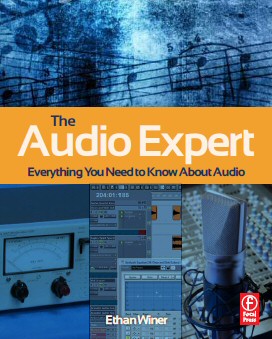 |
In 2012 I wrote my second major book, The Audio Expert which is now being used as the main text for the Audio Technology course at Notre Dame University, Tufts, and several recording colleges. In 2013 I did a second AES workshop to explain how audio gear is spec'd and measured, and that video is also online. Then in 2014 I got back to my guitar roots and spent most of a year practicing to perform Tchaikovsky's Rococo Variations for Cello (!) with our local symphony, documented in THIS video. More recently, in 2025, I wrote THIS book containing more than 80 electronic audio circuits for both hobbyists and professional engineers.
Entire contents of this web site Copyright © 1997- by Ethan Winer. All rights reserved.